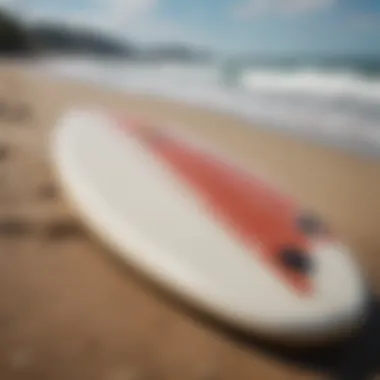The Best Mid-Length Surfboards: A Comprehensive Guide


Intro
Mid-length surfboards are an increasing favorite among surfers, striking a balance between performance and stability. They cater to both beginners and skilled surfers, offering versatility for various types of waves. This article will delve into the features that define mid-length boards, their advantages, ideal usage conditions, and will highlight some of the finest models available in the market.
Equipment and Gear
In the context of surfboards, the focus shifts primarily on the board itself, but various pieces of gear enhance the overall surfing experience. Understanding the essential elements can significantly impact performance and safety.
Essential Accessories for Surfing
- Leash: A durable leash is critical to keeping the board attached to you. Brands like Dakine and Creatures of Leisure are reliable.
- Surf Wax: The right wax is important for grip. Choose according to water temperature. Sticky Bumps offer various options to suit different conditions.
- Wet Suit: For colder climates, a good wetsuit is needed. O'Neill and Rip Curl are favored choices. Select one based on thickness and fit to ensure comfort and mobility.
Maintenance and Care for Surfboards
Taking care of surfboards will prolong their lifespan. Regular rinsing after use helps remove salt and sand. Storing the board in a cool, shaded area avoids sun damage. Consider using a board bag for additional protection.
Recommended Brands
Some well-known brands stand out in the mid-length surfboard segment, such as:
- Channel Islands: Known for their innovative designs and quality.
- Haydenshapes: Combines aesthetics with functionality.
- Surftech: Offers a wide range of boards including eco-friendly options.
Techniques and Training
Mastering mid-length surfboards involves developing specific skills and techniques to maximize performance.
Skills Development
- Paddling Techniques: Proper paddling can improve wave catching. Focus on positioning your body correctly and maintaining a steady stroke.
- Turning: Practice smooth transitions by leaning into turns to maintain speed and control.
Training Exercises
To enhance strength and endurance, consider:
- Core Workouts: Engage in exercises like planks and sit-ups to strengthen your core, which is crucial for balance.
- Cardio Training: Activities like running or swimming can boost overall stamina, critical for long surf sessions.
Safety and Risk Management
Safety cannot be overstated in surfing. Understanding risks can lead to better preparedness.
Key Risks to Consider
- Wave Conditions: Knowledge of tide patterns and wave sizes is crucial. Always check local conditions before heading out.
- Injuries: Collisions with the board or other surfers can occur. Always surf in designated areas and keep awareness of your environment.
Risk Mitigation Strategies
- Buddy System: Surfing with a partner can enhance safety. Look out for one another.
- Emergency Plan: Have a plan ready in case of accidents. Knowing basic first aid is advantageous.
Lifestyle and Community
Surfing is more than a sport; it is a lifestyle. Connecting with the community fosters a deeper appreciation for the sport.
Lifestyle Tips
- Balancing Physical Activity: Engage in complementary fitness routines to improve overall health. Surfing workouts can be incorporated into regular training schedules.
- Mental Well-being: Spend time in nature. Surfing can be meditative and a great stress reliever.


Engaging with the Surf Community
Community events often highlight local surfer talents. Participate in surf meetups, or join forums like Reddit to discuss gear and share experiences. Building networks can enhance your surfing journey.
"Surfing requires patience and persistence; the more time you invest, the greater the rewards."
Prelude to Mid-Length Surfboards
Mid-length surfboards have emerged as a popular option among surfers who seek a balance between maneuverability and stability. This article offers a deep dive into understanding what mid-length surfboards are, highlighting their unique characteristics and advantages. These boards serve as a bridge, allowing both novice and experienced surfers to explore various wave conditions more effectively. With their distinct design and functionality, mid-lengths can enhance the surfing experience.
Definition of Mid-Length Surfboards
A mid-length surfboard is generally defined as one that falls between 7 to 9 feet in length. This size provides a sweet spot that combines the traits of shorter performance boards with the stability of longboards. The mid-length features a wider nose and a more generous tail, which contributes to improved paddling efficiency and stability. The combination of these elements allows surfers to catch waves earlier and maintain control, especially when navigating smaller or inconsistent surf.
Historical Context
Understanding the history of mid-length surfboards helps contextualize their current popularity. These boards first gained attention in the 1960s, during a time when surf culture was evolving rapidly. Surfers began experimenting with different shapes and lengths to adapt to various wave conditions. Mid-length designs offered an alternative to both the longboards, which dominated the era, and the shorter performance boards that emerged later. As surfers sought versatility, mid-length boards filled a niche that allowed for both relaxed paddling and responsive maneuvering. This historical backdrop set the stage for the modern incarnation of mid-length surfboards, making them relevant today in various surfing communities.
Characteristics of Mid-Length Surfboards
Understanding the characteristics of mid-length surfboards is crucial for any surfer looking to optimize their performance in the water. These boards typically measure between 7 to 9 feet, falling into a unique category that combines the agile qualities of shortboards with the stability typically found in longboards. This blend allows surfers to navigate varying wave conditions effectively and enhances their overall experience.
Dimensions and Volume
Dimensions play a significant role in the performance of mid-length surfboards. Surfboard volume, often expressed in liters, affects how the board displaces water and, consequently, its buoyancy.
- Length: Mid-length boards, ranging from 7 to 9 feet, cater to both beginners and seasoned surfers. The length aids in catching waves more efficiently, providing different angles for riding.
- Width: Wider boards offer more stability, allowing for easier paddling and balance. A wider nose can also enhance the paddle power, aiding in wave-catching.
- Thickness: The thickness of a board affects its overall volume. Thicker boards displace more water, which translates into increased floatation, making them more forgiving in small waves.
Understanding these dimensions helps surfers select a board that best suits their style and surf conditions. A board with the right volume can boost performance and ensure a smoother ride.
Shape and Tail Options
The shape of a mid-length surfboard significantly influences its performance. The outline shape dictates how the board behaves in various waves.
- Nose Shape: A wider nose offers stability, while a pointed nose can enhance maneuverability.
- Tail Shape: Different tail designs, such as squash, round, or pintail, affect how the board performs. A squash tail offers quick release in turns, while a round tail provides smoothness in bigger waves. A pintail can enhance control, especially in steeper waves.
Each shape serves specific purposes, influencing how surfers carve through water and perform tricks. Tail options provide an additional layer of customization depending on riding style and preferred wave size.
Construction Materials
The construction materials of mid-length surfboards also demand attention. These boards traditionally use fiberglass and foam, but recent designs have introduced alternative materials as well.
- Epoxy Resins: These materials offer greater durability and are often lighter than traditional fiberglass boards. This enhances performance, making it easier to control the board during rides.
- Polyurethane Blanks: These are common in board construction, providing flexibility and durability. They are particularly favorable for those looking to ride aggressively.
Selecting the right construction material can influence not just performance but also the longevity of the surfboard. It is vital to consider one's style and the conditions of expected surf when making a choice.
A mid-length surfboard’s characteristics allow for adaptability, making it suitable for various surfers at different skill levels.
By understanding these specific elements, surfers can make informed decisions about their equipment. A well-chosen mid-length surfboard will enhance the surfing experience, providing both stability and performance.
Benefits of Using Mid-Length Surfboards
Mid-length surfboards are gaining recognition among surfers of all skill levels for their unique advantages. The benefits of these boards encompass functionality, versatility, and user-friendly characteristics. Each aspect contributes significantly to the overall surfing experience, making mid-length surfboards an appealing option for both novices and veterans.
Versatility in Wave Conditions


One of the most notable attributes of mid-length surfboards is their versatility across various wave conditions. These boards typically range from 7 to 9 feet in length, allowing them to perform well in both small and medium-sized waves. Their design strikes a balance between longboards and shortboards, meaning they can adapt to changing surf without compromising performance.
Surfers can experience a wide range of wave formations. Mid-length boards enable smooth rides on smaller waves while also holding their own in more challenging conditions. This adaptability allows surfers to enjoy their time in the water without needing multiple boards for varying surf scenarios.
Ease of Paddling
Another critical benefit of mid-length surfboards is their ease of paddling. The added length, combined with the wider surface area, facilitates efficient paddling. This means that surfers spend less time waiting for waves and more time riding them.
Surface area enhances buoyancy, allowing riders to catch waves with less effort. Newer surfers, in particular, will find this feature beneficial as it builds confidence and skills quickly. Additionally, the stability that comes with this buoyancy helps maintain control during the paddle, ensuring a smoother transition as surfers prepare to ride.
Enhanced Stability
Enhanced stability is perhaps the most significant advantage of mid-length surfboards. The balance between length and width contributes to a sturdy platform beneath the surfer, making it easier to balance and maneuver.
This stability is particularly valuable for those who may struggle with maintaining equilibrium on shorter boards. Surfers can focus more on their technique and less on falling off their board. Furthermore, the increased width contributes to a more forgiving ride, especially in choppy or bumpy conditions, making it an ideal choice for artists exploring new techniques.
"Mid-length surfboards offer a unique combination of stability and responsiveness, appealing to a broad spectrum of surfers, regardless of their skill level."
Choosing the Right Mid-Length Surfboard
Selecting the appropriate mid-length surfboard is essential for optimizing your surfing experience. The right choice will significantly impact your performance in the water, enhancing both enjoyment and skill development. Several factors play a crucial role in this decision-making process, such as your skill level, the types of waves you'll be riding, and personal preferences. Understanding these elements can lead you to a surfboard that not only meets your immediate needs but also assists in your growth as a surfer.
Assessing Skill Level
Assessing your skill level is the foremost step in choosing a mid-length surfboard. Beginners may find broader, more stable boards easier to manage. These models typically have a larger volume, enabling better buoyancy. Sophisticated surfers might prefer a more refined setup that allows for greater maneuverability. Therefore, it is critical to evaluate where you stand in your surfing journey.
- Beginners should lean towards boards like the Catch Surf Beater or the Soft Top Surfboard for ease of use.
- Intermediate surfers may benefit from boards such as the Lib Tech Shortboard as they offer a blend of stability and performance.
- Advanced surfers often look for something like the Hayden Shapes Hypto Krypto that can hold up in challenging conditions and enhance their skill repertoire.
Identifying Wave Types
The kind of waves you plan to surf is another critical factor to consider. Understanding how different boards perform in various wave conditions can aid you in selecting the right surfboard. Mid-length surfboards excel in a broad spectrum of wave types but some models outperform others in specific circumstances.
- Small, mushy waves generally require boards with more volume, which can catch waves easily. Examples include the Catching Waves Mid-Length.
- Powerful, steep waves necessitate a board that is more agile, such as the Jourey Mid-Length.
- Choppy conditions may be easier to handle on a stable, wider surfboard like the DHD Mid-Length.
Personal Preference Considerations
Your personal preferences also carry significant weight in the selection process. Factors such as aesthetics, color preference, and even brand loyalty can influence your choice of mid-length surfboard. Each surfer has a different feeling or connection with the board that goes beyond its performance attributes.
When choosing, think about:
- Style: The aesthetics of the board often play a role; you might prefer a unique design or color.
- Comfort: It is vital to feel comfortable and confident on your board. A board that feels good physically can enhance your surfing experience.
- Brand Reputation: Trust and experiences with certain brands may affect your decision. Well-regarded companies like Channel Islands or Pyzel could be your nod in choosing a board.
When navigating through these various considerations, remember that the ideal surfboard is one that aligns with your skill level, the waves you ride, and your personal tastes. Taking the time to reflect on these elements will ultimately lead to a more satisfying surf experience.
Top Mid-Length Surfboards on the Market
The selection of top mid-length surfboards available today serves as a crucial focus in this article. Surfers, whether beginner or seasoned, need to grasp the significance of choosing the right board. Mid-length surfboards sit comfortably between shortboards and longboards. They provide a unique blend of speed, maneuverability, and stability that appeals to various surfers in multiple conditions.
Choosing the best mid-length surfboard can make a noticeable difference in performance. When considering a purchase, factors such as the shape, material, and brand reputation come into play. In addition, knowing how each brand delivers in performance enhances the decision-making process. Recognizing which surfboard suits individual needs can lead to a more enriching experience on the waves.
"The right surfboard can turn an average session into an extraordinary one."
Brand A: Performance Overview
Brand A, known for its advanced design techniques, is a notable player in this category. The performance of the mid-length boards produced by Brand A primarily relies on their innovative shapes and materials. Many users have pointed out how these boards excel in a variety of wave conditions. The construction typically involves a lightweight foam core, allowing for easier paddling and faster rides.


Surfers often highlight the balance found within Brand A models, giving them confidence in both small and larger swells. Riders appreciate the stability during carving turns and the ability to maintain speed.
Brand B: Performance Overview
Brand B offers a different take on mid-length surfboards, focusing on durability and robust construction. The boards are designed with a combination of traditional craftsmanship and modern technology. Performance wise, these boards tend to be slightly heavier, providing excellent stability in rough waters.
Surfers who favor power and consistency in their ride may find Brand B’s offerings appealing. The design aspects include wider tails which aid in generating speed while maintaining control. Customer feedback often emphasizes the ability of Brand B boards to perform admirably in choppy sea conditions.
Brand C: Performance Overview
Brand C stands out for its emphasis on versatility. The mid-length boards under this brand come with several options tailored to different surfing styles. Enthusiasts frequently commend these boards for their balance between rigidity and flex. Riders find that the boards allow them to tackle various wave types efficiently.
Additionally, the sleek designs are visually appealing, which is often an essential factor for many surfers. The overall consensus among users leans towards a positive performance experience, particularly in summer swells. The brand's reputation for excellent customer service also adds to its desirability.
In summary, understanding the performance characteristics of these brands is essential for any surfer looking to explore mid-length surfboards. Each brand presents unique features that cater to different surfing preferences and skill levels.
Maintenance and Care for Mid-Length Surfboards
Proper maintenance and care of mid-length surfboards is crucial for maximizing their lifespan and performance. Just like any other sports equipment, surfboards need attention to stay in optimal condition. This ensures safety during the ride and enhances the overall surfing experience. Taking good care of your surfboard should be seen as an investment in your surfing abilities and enjoyment.
Routine Inspections
Routine inspections are a foundational aspect of maintaining mid-length surfboards. Surfers should regularly check for any visible damage, like cracks, dents, or delamination. These types of issues can lead to more significant problems if left unattended. A simple procedure can be performed at home:
- Visual Check: Look over the entire surface for any irregularities.
- Pressure Test: Gently press on different areas to feel for soft spots that may indicate hidden damage.
- Leash and Fins Inspection: Ensure that fins are securely attached and that the leash is in good condition.
This practice can help prevent water from entering the board, which often leads to deterioration of the internal structure. Regular maintenance allows surfers to identify minor issues before they escalate, preserving their investment and enhancing performance.
Waxing and Storage
Waxing is an essential task for improving grip and performance on mid-length surfboards. A properly waxed board can make a significant difference, especially when paddling out or catching waves. Here are some key features of this process:
- Choose the Right Wax: Different water temperatures require different types of wax to maintain grip effectively. Cold water wax is softer, while warm water wax is harder.
- Application Process: Apply a base coat of wax first, followed by regular application to maintain grip. Use a circular motion to work the wax into the board.
As for storage, where and how you keep your surfboard will impact its longevity. Here are some tips for proper storage:
- Avoid Direct Sunlight: Prolonged exposure to UV rays can weaken the board’s materials. Store it in a shaded or dark environment when not in use.
- Use a Board Bag: A quality board bag provides protection from physical damage. It can also help regulate temperature.
By following these practices for waxing and storage, surfers can significantly prolong the life of their mid-length surfboards, ensuring they remain ready for the next adventure.
End: Embracing Mid-Length Surfboards
The exploration of mid-length surfboards reveals significant insights into balancing performance and stability in surfing. This section wraps up the critical discussions surrounding these boards, emphasizing their role for various surfers. Mid-length boards provide a unique position between longboards and shortboards, making them adaptable for different skill levels and wave conditions. What sets them apart is their ability to offer both maneuverability and ease of paddle, crucial factors for any surfer.
Another important element to consider is the versatility that mid-length surfboards bring to the table. They are not only suitable for beginners trying to build their confidence but also for experienced surfers seeking a different style. The ability to surf in varied conditions expands the board's appeal significantly.
In addition, the care and maintenance of mid-length surfboards can prolong their lifespan, ensuring investment in quality gear pays dividends over time. It is vital to integrate proper handling routines, such as regular inspections and correct storage, to protect these boards from damage. The conversation about this surfing gear thus extends beyond just selecting a board; it also encompasses ongoing care and engagement with the sport.
Overall, the conclusion underscores how mid-length surfboards represent a valid choice that should be embraced by those looking for a balanced approach to their surfing experience. The insights gathered from this guide can empower surfers to make informed decisions suited to their preferences and environmental conditions.
Recap of Key Points
- Mid-length surfboards offer a balance of performance and stability.
- They are adaptable across different skill levels and wave types.
- Proper maintenance can enhance the longevity of boards.
- They provide versatility for various surfing styles and conditions.
Future Trends in Mid-Length Surfboards
Looking ahead, we can anticipate developments in mid-length surfboards driven by technological advancements and changing surfer preferences. New materials may emerge, offering better durability while reducing weight, enhancing overall performance. Additionally, we may see a range of shapes and designs tailored to specific wave types, reflecting a more personalized approach to surfing.
Moreover, sustainability in surfboard production is becoming increasingly relevant. Eco-friendly materials and practices will likely become standard within the industry, appealing to environmentally conscious surfers. This trend will not only attract new enthusiasts but also align with broader movements toward sustainability in sports.
Engagement with online communities, such as on platforms like Reddit, can offer valuable insights into consumer preferences. Through reviews and discussions, surfers can influence the design and functionality of new mid-length models. All these factors suggest that mid-length surfboards will continue to evolve, solidifying their position in the surfing world.















